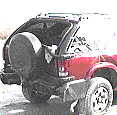


 |

 The external forces can cause damage to the vehicle and injury to your body. The amount of damage or injury is determined by the magnitude of the force and by the part of the vehicle or the body the force is applied to. Minimizing damage to the vehicle and injury to the occupants often present conflicting requirements.
Bumpers are designed to protect the car, airbags are designed to protect people. Neither of these does a perfect job. Both involve trade-offs. To learn more about air-bags visit the
Insurance Institute For Hyway Safety where we got the air-bag picture.
The external forces can cause damage to the vehicle and injury to your body. The amount of damage or injury is determined by the magnitude of the force and by the part of the vehicle or the body the force is applied to. Minimizing damage to the vehicle and injury to the occupants often present conflicting requirements.
Bumpers are designed to protect the car, airbags are designed to protect people. Neither of these does a perfect job. Both involve trade-offs. To learn more about air-bags visit the
Insurance Institute For Hyway Safety where we got the air-bag picture.
 When a light car and a massive truck collide, momentum conservation requires that
When a light car and a massive truck collide, momentum conservation requires that
Note that an object with large mass will experience a smaller change in speed than the object with the small mass. As the occupant of the vehicle it is in your interest that the vehicle does not undergo big changes in speed in a short time. Since you yourself are a moving object subject to Newton's laws, you will need external forces yourself to change your motion. These will come from the seat, the seat belt, airbags or other parts of the vehicle such as the steering column.
 If the vehicle comes to a stop, or if the speed is substantially decreased, the lost kinetic energy of the vehicle transforms into some other form. This process will involve work, the integral of force with respect to displacement. The bigger the displacement the weaker the force (and damage and injury.) Hard stationary objects don't allow much displacement and cause more damage and injury than soft, movable or breakaway objects. Next time you are driving or riding in car, look around and see how modern vehicle and highway designs surround you with soft, breakaway barriers whenever possible. Wide medians, breakaway lamp posts, energy absorbing barriers at underpasses, padded dashboards.
If the vehicle comes to a stop, or if the speed is substantially decreased, the lost kinetic energy of the vehicle transforms into some other form. This process will involve work, the integral of force with respect to displacement. The bigger the displacement the weaker the force (and damage and injury.) Hard stationary objects don't allow much displacement and cause more damage and injury than soft, movable or breakaway objects. Next time you are driving or riding in car, look around and see how modern vehicle and highway designs surround you with soft, breakaway barriers whenever possible. Wide medians, breakaway lamp posts, energy absorbing barriers at underpasses, padded dashboards.
Unfortunately, every day there are thousands of traffic accidents throughout the United States. While most accidents are minor, a significant number of accidents result in some form of legal action, either civil or criminal.
When legal action occurs, the courts get technical help from
(1) one of the many traffic institutes around the country, and
(2) from engineers and scientists whose specialty lends itself to some aspect of
accident reconstruction.
Physicists fall into the second category.
 It should be noted that it is rare for a reconstructionist to have an opportunity to be at a "hot" accident site. The reconstructionist usually has to rely on evidence gathered by the police or other investigators.
It should be noted that it is rare for a reconstructionist to have an opportunity to be at a "hot" accident site. The reconstructionist usually has to rely on evidence gathered by the police or other investigators.
At the simplest level, a reconstruction might involve computing the location of a vehicle at various times before a collision. Or the problem might be to determine how far a vehicle traveled during the time when a driver was perceiving and reacting to the incident. Accident reconstructionist are paid up to several hundred dollars per hour for their time.
Of more interest are situations involving vehicles skidding, colliding, or yawing (sideslipping while traversing a curve). In these cases, the concepts of energy, momentum, and force are central.
 As an example, suppose that a vehicle is found to have skidded 130 feet along a flat road, coming to a complete stop. Given that the coefficient of friction of the tire/road surface is known to be between 0.55 and 0.70, what is the range of possible speeds?
As an example, suppose that a vehicle is found to have skidded 130 feet along a flat road, coming to a complete stop. Given that the coefficient of friction of the tire/road surface is known to be between 0.55 and 0.70, what is the range of possible speeds?
|
original kinetic energy = energy lost in sliding
1/2 mv2 = f mg d where d = distance of the skid, f = coefficient of friction
Solving for v gives;
|
With the speed and direction of both vehicles known just after impact, conservation of momentum can be used to determine the speed and direction of both vehicles just prior to impact (again, skid marks specifying pre-impact direction).
Finally, skidding analysis applied to the pre-impact skid marks allows a determination of the original speeds of both vehicles.
 It turns out that tests with hundreds of vehicles have shown that there is a linear relationship between the amount of residual crush (crush remaining after the collision) and the energy lost to deformation and crush.
It turns out that tests with hundreds of vehicles have shown that there is a linear relationship between the amount of residual crush (crush remaining after the collision) and the energy lost to deformation and crush.
|
Maximum sideways force of friction = vehicle mass x centripetal acceleration
or fmg = mv2/r where r = radius of curvature of yaw mark Thus v = (fgr)1/2 |
The final two links are not related to physics but you might find them interesting.
7.  8.
8. 
 1. What do traffic accident investigators use to estimate the speed and direction of travel before the accident.
1. What do traffic accident investigators use to estimate the speed and direction of travel before the accident.
 2. Accident investigator manuals in this country define momentum as weight x velocity. This definition is obviously quite different from the physics definition of momentum as mass x velocity. Why is the former definition just as good for accident reconstruction purposes?
2. Accident investigator manuals in this country define momentum as weight x velocity. This definition is obviously quite different from the physics definition of momentum as mass x velocity. Why is the former definition just as good for accident reconstruction purposes?